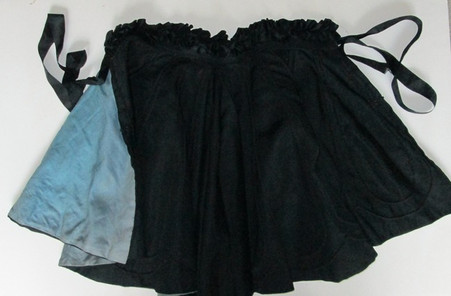 Loading... Please wait...
Loading... Please wait...-
Call us on (973) 810-2976
- My Account
- Gift Certificates
- Items / $0.00
All prices are in All prices are in USD
Categories
- Home
- Sold, Hold, Layaway items
- Civil War Mourning Cape and Shawl (SOLD,J)
Civil War Mourning Cape and Shawl (SOLD,J)
Out of Stock
Product Description
This Civil War era Mourning Grouping consists of a cape and two shawls. There is a possibility that maybe one was used as a veil, but I am not sure of this – even though you can see through the cloth. Most of the pieces appear to be hand-sewn and the cape definitely has some wear to the blue lining.
The wearing of black is a custom that has been observed for centuries. It was thought to make mourners draw less attention to themselves so that Death would not claim them as its next victim. A Victorian woman donned what was known as "widow's weeds" within twenty-four hours of her husband's death. For a year and a day, she wore full mourning which consisted of dull black clothing trimmed with crepe, and a weeping veil.
Although women had held prominent roles in mourning rituals throughout the Victorian era, the enormous number of casualties brought on by the Civil War necessitated significant alterations in their responses. During the first year of fighting, many Confederate women tried to maintain the rituals of dress and behavior that accompanied death. But with the increasing economic hardships, many middle- and upper-class Southern women simply could not afford to continue to abide by the etiquette.
When Confederate first lady Varina Davis went into mourning for her son, Joseph, in April 1864, she wore a black dress of inexpensive cotton. Warrenton, Virginia resident Susan Caldwell's husband advised her in the autumn of 1864 against wearing black following the death of their young daughter. With "war and penury upon us," he thought it unwise to spend the money on an unnecessary purchase. Young Lizzie Alsop of Fredericksburg was undecided about wearing black after the death of her grandmother in March 1863. "For tho' we should like to, mourning is so high that I do not know whether it would be right for us to wear it or not," Lizzie commented. With as many as one out of every four Confederate soldiers dying, women across the region were thrown into a perpetual state of mourning and often forced to abandon their rituals of dress and self-imposed seclusion. According to Jane Peters Estes, an authority on death customs in Civil War-era America, in the state of Alabama alone, there were over 80,000 widows.
Mourning women wore a veil in public to shield their tears from onlookers. Estes also stated that, “they believed that spirits of the departed would hover around those they loved. And if a passerby looked directly on the mourner's face, that spirit might attach itself to that person. So, the veil was a protection for the wearer as well as a protection for others.”
Mourning attire became some of the first store-bought clothing items during a time when most clothes were handmade at home. Death could come unexpectedly and the bereaved had to be prepared. Those who could not afford to buy ready-made items paid to have their own clothing dyed or dyed it themselves at home, in the back yard because of the dye's pungent odor.
I have no history on this unique little grouping other than it came out of Pennsylvania. Overall all three pieces are in very nice condition, except a portion of the blue lining on the cape is missing and for some fraying of the cape from extended wear.



